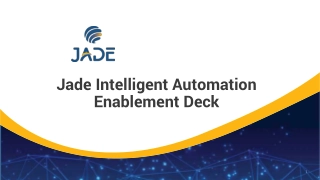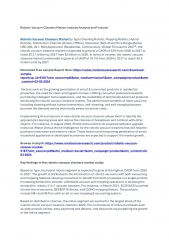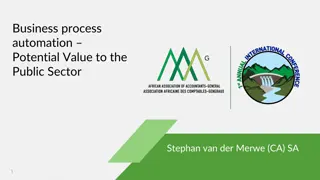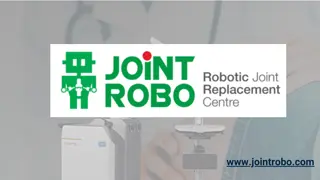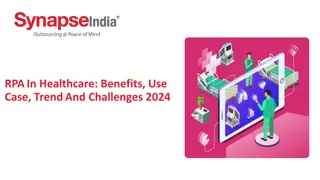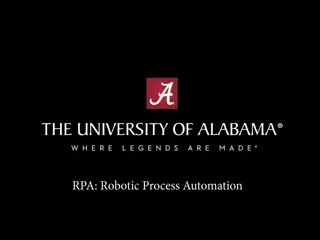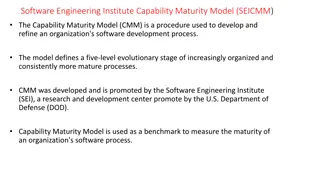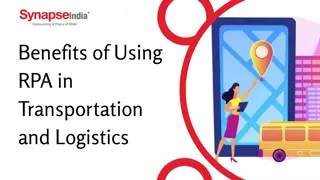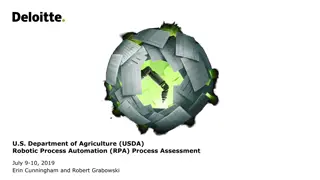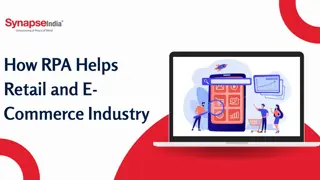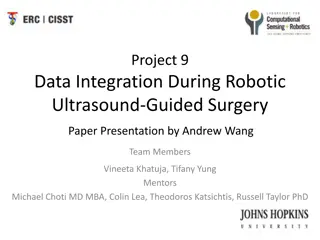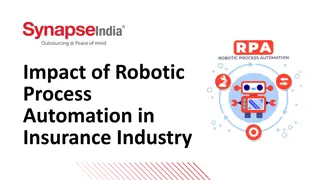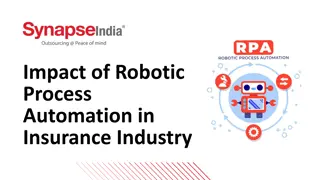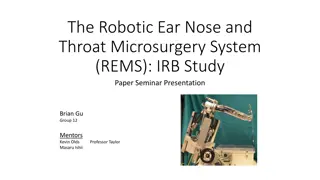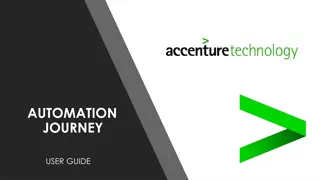Developing Robotic Process Automation (RPA) Capability - NLIT Summit 2023 in Milwaukee, WI
This article discusses the initiative of developing Robotic Process Automation (RPA) capability in the national interest at the NLIT Summit 2023 in Milwaukee, WI. The focus is on maximizing efficiency, agility, and effectiveness by implementing RPA to automate digital tasks, reduce manual labor, and free up resources for strategic initiatives.
Download Presentation

Please find below an Image/Link to download the presentation.
The content on the website is provided AS IS for your information and personal use only. It may not be sold, licensed, or shared on other websites without obtaining consent from the author. Download presentation by click this link. If you encounter any issues during the download, it is possible that the publisher has removed the file from their server.
E N D
Presentation Transcript
Exceptional service in the national interest DEVELOPING A ROBOTIC PROCESS AUTOMATION (RPA) CAPABILITY NLIT SUMMIT 2023 | MILWAUKEE, WI Rich Griego, Solution Architect June 28, 2023 This article has been authored by an employee of National Technology & Engineering Solutions of Sandia, LLC under Contract No. DE-NA0003525 with the U.S. Department of Energy (DOE). The employee owns all right, title and interest in and to the article and is solely responsible for its contents. The United States Government retains and the publisher, by accepting the article for publication, acknowledges that the United States Government retains a non-exclusive, paid-up, irrevocable, world- wide license to publish or reproduce the published form of this article or allow others to do so, for United States Government purposes. The DOE will provide public access to these results of federally sponsored research in accordance with the DOE Public Access Plan https://www.energy.gov/downloads/doe-public-access-plan. Sandia National Laboratories is a multimission laboratory managed and operated by National Technology and Engineering Solutions of Sandia LLC, a wholly owned subsidiary of Honeywell International Inc. for the U.S. Department of Energy s National Nuclear Security Administration under contract DE-NA0003525. SAND2023-05501C
AGENDA Inception Evaluation Initial Development Governance Path Forward 2
INCEPTION PROBLEM IDENTIFICATION Maximizing our efficiency, agility, and effectiveness with increasing workloads and limited resources Contributing Points: Sandia s people are its most valuable resource. Manual labor intensive processes exist that occupy valuable time from high skill people The value of accuracy/repeatability and the cost of errors/rework Increasing cost of customization and on ongoing battles with technical debt Initial Scenario: Problem raised by functional partners in HR Solutions initially Case management, hundreds of cases created per day some standard requiring repeatable manual intervention Many labor intensive, manual processes across multiple systems In response to this challenge, we identified the need to implement Robotic Process Automation (RPA) to streamline our operations, reduce manual labor, and free up resources for more strategic tasks. 3
WHAT IS ROBOTIC PROCESS AUTOMATION (RPA)? Robotic Process Automation (RPA) is software capability that enables automation of digital tasks. RPA is a low code/no code software capability that allows a user to configure scripts ( bots ) to execute graphical user interface (GUI) navigation, clicks, keystrokes and calls in an automated manner The bots can be used to emulate the manual tasks for a IT or business process The bots can manipulate data, move/transform data between applications to execute system transactions RPA bots can operate quickly on demand with 100% reliability and precision Bots are developed and run from a control room GUI recorder, scripting, tools, and bot packages are used to create attended and unattended automations 4
INCEPTION - USE CASES FOR RPA When compared to other automation mechanisms, RPA is particularly good at mimicking human computer interactions via mouse and keyboard input. From an end user stand point and documentation perspective this makes basic RPA configuration digestible for non- technical populations, since the bot can execute a task the same way a human would. In general, RPA is well suited for processes where: The process has well documented, straight forward, non-variable logic The process tasks are currently manual and repetitive via GUI of one or more systems The software or data sources required to execute the process do not have mature APIs Enhancement to the process and supporting applications that would enable more sophisticated API based automation aren t feasible 5
INCEPTION WHAT WE LEARNED Partnership between IT and Business from day one IT may not always be the initial driver for an RPA capability, but for it to become a sustainable and secure service its critical IT own the capability There may be the perception that IT is slowing adoption, but RPA is software development and that the principles of good software development apply to RPA Leverage the initial interaction to educate partners about existing automation capabilities Begin considering funding model and team structures early in the process before a tool is acquired 6
EVALUATION Internal Evaluation, comparisons to existing automation technology at Sandia Eggplant Test complete Python scripting Selenium Katalon, etc. Leveraged existing contractual relationships with software vendors Used internal experience with other automated testing tools (i.e. Test complete) On prem trial installation and a hands-on evaluation to develop a use case Involved cyber during the evaluation phase Evaluated software provider support and roadmap during evaluation 7
EVALUATION WHAT WE LEARNED Evaluate existing internal automation capabilities before procuring an RPA Cyber partnership for a new capability is standard at Sandia, but is a necessity when approaching credential management standards for RPA Automation success was dependent on external factors remove where possible (DAAS) User system preferences in the GUI can interfere with the way an RPA script interacts with on-screen elements. (i.e. night mode, window size, screen resolution) Bot development was more labor intensive than anticipated, even with experienced devs Contract with automation resource providers to achieve velocity and partner with experienced Sandia devs to build competency internally Basic technical skillset for technical developers Adding bot packages (small application plug-ins) securely is labor intensive 8
INITIAL DEVELOPMENT Began with our first partner in HR, case management Counterintelligence Questionnaire Instructions Agile software development methods Process documentation was not solid, and process was evolving Functional users were testers from day one Finance provided FY23 investment funding and joined the product ownership Finance had many use cases initially and needed assistance assessing feasibility Process feasibility template and complexity calculator leveraged 9
INITIAL DEVELOPMENT USE CASE SELECTION Stability Processes and technology solutions should not change very frequently. Processes have standardized corporate supported data sources access is appropriate for credentials used within the script. Data Quality Processes should have appropriate volume to justify investment, but not so often as to introduce risk or be better suited for another automation solution. Volume/Iteration Process Quality Processes are well-architected, well-implemented and well-documented. Processes have well documented, straight forward, non-variable logic that can be expressed and resolved through regular expressions. Process Logic No RPA AlternativeEnhancement to the process and supporting applications that would enable more sophisticated API based automation aren t feasible 10
INITIAL DEVELOPMENT BOT PIPELINE In Production Counterintelligence Questionnaire, Human Resources Home Checks Process, Finance In User Acceptance Testing Conflict of Interest, Human Resources Payroll Separation Phase 1, Finance In Development Student Counterintelligence Questionnaire, Human Resources Payroll Separation Phase 2, Finance In Scoping/Documentation Prudential, Human Resources Reclassification Purchase Orders, Finance Telecommuting/Remote Work Data Entry, Human Resources Etc. 11
INITIAL DEVELOPMENT IMPACT An initial step for establishing if a process is fit for automation is use of a process feasibility template to assess volume and handling time to gauge impact. The template assesses data quality, process stability, and other inputs to produce a feasibility score. Counterintelligence Questionnaire, Human Resources In FY22 the over 5,000 transactions were manually handled which moving forward will be addressed by this bot. At an average 5 min handling time per case, the estimated time saved is 400+ hours annually. Home Checks, Finance On average the over 13,500 transactions are manually handled per year (~260/week) which moving forward will be addressed by this bot. At an average 2.5 min handling time mailing, the estimated time saved is 500+ hours annually. 12
INITIAL DEVELOPMENT WHAT WE LEARNED Use case identification is critical - establish criteria for identifying and prioritizing Ensure that the criteria evolve to reflect your level of maturity, skill and investment RPA Agile methods are effective for incremental delivery, but process and technology changes mid development are very disruptive resulting in a waterfall approach to requirements Allowing career growth and leveraging devs from the projects where tools will be automated were advantages Managing the RPA work in conjunction with the other work on same tool was a challenge The Recorder tool has significant limitations (such as dynamic objects in GUI), can be useful for prototyping but is rarely a substitute for an automation script API utilization, within the confines of RPA use, should be prioritized Functional partners may be hesitant to share monetized labor savings as a result of RPA 13
GOVERNANCE PURPOSE RPA Governance Consolidate front door for automation services in IT Keep processes lightweight, communicate clearly why practices are required Enforce criteria for when RPA is used and in what circumstances Own RPA roadmap, including thresholds for developer personas (i.e. technical or citizen developers) Enforce Solution Delivery Lifecycle (SDL) and corporate/regulatory requirements on automations RPA governance should focus on three key milestones Process selection criteria and development standards for RPA Review and approval of potential RPA use cases Validation of the automations before promoting to production 14 14
GOVERNANCE BOARD STRUCTURE RPA Governance Board Membership A business product owner to represent the functional teams and the citizen developers A member of the technical team responsible for RPA operations A technical lead to serve as automation architect and enforce development standards 15 15
GOVERNANCE ENFORCE STANDARDS Establish best practices, development and operational standards, for example: Thresholds and criteria for developer personas Error and process logging standards Identity/access control policies and credential management Authentication methods and guard rails Code versioning standards and hygiene Exception handling standards Standard reusable bots for handling common activities Bot package expansion and release 16 16
GOVERNANCE WHAT WE LEARNED Governance and Ownership IT should own the capability Begin with technical developers and partnership with product owners in Finance and HR There will be a lot of interest as soon as you begin delivering results Protect and mature your capability with core functional partners before over extending Partner with other automation capability owners plant seeds for a Center of Excellence (CoE) Developer Community Establish vision for the developer community RPA success depends on aligning technologies and processes with developer personas Define development standards, compliance rules, security practices Align SDL practices to RPA governance to mitigate risk After stability is achieved with the technical developers proceed with citizen developers 17
THE PATH FORWARD - VISION Robotic Process Automation is a mature capability owned by IT at Sandia Developers from across IT collaborate with the RPA dev team to build automations for our customers Security best practices and collaboration are critical to the success of the capability RPA is used when it is well-suited to automating the process, and avoided when it is not Initial RPA governance as an input to existing IT Software governance Process selection criteria for RPA Review and approval of potential RPA use cases Validation of the RPA code and security before promoting to production There are clear expectations, communication and pipeline for automation candidates Once initial RPA governance is mature an Automation Center of Excellence (CoE) is pursued Citizen developers are trained and assisted by IT to build RPA automations within predefined thresholds with guard rails 18
THE PATH FORWARD Remainder of FY23 Continue bot development for HR and Finance Work SDL iteration for unattended bots Screen use cases for FY24 Investment Continue governance design Establish thresholds developer personas FY24 Citizen developer pilot (Ambassadors) Mature RPA governance and evolve into an Automation CoE Continued HR and Finance development Unattended bots FY25 Expanded citizen developer rollout (pending pilot) Onboard functional partners beyond HR and Finance 19 19
QUESTIONS? 20


